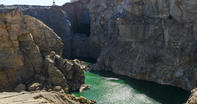SA Mining Company
Besides the obvious pitfalls and difficulty in mining, transporting and feeding the miners in the Namaqualand interior, Fannin (Honorary Secretary of the South African Mining Company) proceeded to issue a prospectus for the South Africa Mining Company in 1846.

Shares were sold for 10 shillings apiece, directors were appointed and a mining team was equipped. They reached the mine later that same year and started digging. Samples were sent to Cape Town and the ore was found to contain 70% copper. But transportation continued to be the major obstacle. There was a rough wagon trail to the coast, but the heavy ore could not be profitably conveyed in this way. Sailing down the Orange, as was originally intended, was no Sunday outing and, in any case, there were few suitable anchorages along the coast.
Eventually, Fannin was reduced to transporting the ore overland to Cape Town. In 1847, shareholders were asked to cough up an additional 10 shillings a share to keep the mine going. Fannin, for his part, sold his shares and bought a farm in Natal. By 1848, shares in the South African Mining Company were worthless and the whole enterprise petered out.
Nevertheless, this was the first commercial mining site in South Africa. A few years after the South African Mining Company wound up its affairs, a German named Von Schlicht went to Namaqualand and stopped at a farm called Springbokfontein (also known as Melkboschuil or Koperberg). Here he was amazed to see a rich vein of copper sticking out the mountainside, in plain view. He hurried back to Cape Town to try and raise money for a mining enterprise but, unsurprisingly, he found no takers.
The Story of von Schlicht
Dejected, von Schlicht told his sad story to his housemate, a man named Jencken, and then left the colony for several years. Jencken, in the meantime, began working for the company Phillips and King but got himself into financial trouble and wound up owing the company some money.
He offered to repay his debts by travelling to Namaqualand to open a trading store on behalf of his employers. To sweeten the deal, he told his bosses about von Schlicht’s copper find and suggested that he check it out. Jencken’s reports from Springbokfontein were euphoric and Phillips and King sent off an agent, John Wild, to investigate further. This was all done under a veil of secrecy because they didn’t want to tip the hand of the government, or any other interested parties.
Their clandestine approach was just as well because, at that time, the title to the farm Springbokfontein had not yet been granted to the Cloete Brothers, who were resident on the land. And, when the deed was granted in 1850, the government didn’t retain the mineral rights.
A Finalised Deal
Just then, the story goes, Von Schlicht returned to Cape Town. When he heard that his mate, Jencken, was in Namaqualand, Von Schlicht quickly realised that it had something to do with his copper find. He raced up to Springbokfontein, where he apparently found several sacks of copper ore all trussed up and ready to go. There was no sign of Jack Wild or Jencken, so he rushed to the farmhouse and began negotiating with the Cloetes.
The deal was nearly finalised before they all went to bed for the evening. Late that night, Wild returned to the farmhouse and immediately realised that something was up. He sprang into action, woke up the farmer and got him to sign a deed of sale before the sun rose.
And so, on March 15, 1850, Phillips and King purchased the relevant portion of the farm Springbokfontein for the princely sum of £50. This included mineral rights to the entire farm, the right to erect buildings for the purpose of mining, the right to graze such animals as might be needed and the right of access to water. Phillips and King later purchased the remainder of the farm for more than £2000.
By David Fleminger